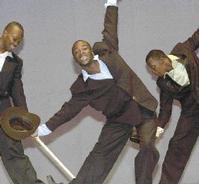Teino Evans, Staff Reporter
Youngsters performing at this year's JCDC Dance Competition held at the Little Theatre, Tom Redcam Drive, St Andrew.
ONCE UPON a time, not long ago, dance was dominated by women, as it would be considered against the norm for a man to even think about donning leotards and trying out his talent.
However, there has been a drastic shift in attitude, as an increasing number of males sought to train and excel in the art, this despite some reservations from sectors of the society who still see dance as a feminine pursuit.
According to Marjorie Whylie, musical director of the National Dance Theatre Company (NDTC), there has definitely been an increased male presence in dance.
"Oh yes, we see it happening in both the traditional and other companies," she said, adding that some of the most outstanding dancers today were males.
Arsenio Andrade, principal dancer and choreographer with the NDTC and also assistant director of Xamaica Dance Company, told The Sunday Gleaner he feels there had to be a change in the culture leading to the influx of male dancers.
MORE MALE DANCERS
"In Jamaica the culture is different. I see more male dancers performing now and I guess it's because some kind of change has happened in the culture. You wouldn't see much male dancers say 20 years ago," Andrade said.
According to him local dance companies have become more exposed, as dancers from all over the world have come to Jamaica and also local dancers have travelled to various parts of the world to perform.
Shaun Anderson, a student at the Edna Manley School of the Visual and Performing Arts, who studies music, drama and dance, has no regrets about his career choice. He believes that males should be bolder and ought to be sure of themselves.
"I think there were always males who wanted to dance, but if you danced you were labelled as being gay. But now males are more sure of themselves. Personally, for me, the reaction from people is different because I behave normal, but even for some of the guys who dance, their behaviour is very feminine," he said.
Kreshna Jones, another student at the Edna Manley College, said for him dancing is just another way of expressing himself, which he enjoys.
"For me, dancing brings out another form of expressiveness in the Arts; it's just another way of expressing. Is not everybody can dance, and your body has to be built a certain way, so if you know you can do it (dance), then why not? It's just another part of expressing yourself," Jones said.
Jones said that he ignores society's views and just does what he enjoys doing.
"There are some males who are afraid of being stereotyped and the stigma that is attached to males who dance. It still stands out, because up to recently I overheard some people talking negatively about guys who dance. You just have to ignore it, really," he said.
DANCEHALL
The professional and semi-
professional male dancers in dancehall have no problem marking out their turf, as they far outnumber the women.
Male dancers have been a dominant dancehall force for
more than a decade, with Buju Banton doing Bogle about the dance invented by the man of that name in the early 1990s. Bogle also appeared in the memorable World Dance video with Beenie Man, as well as in Barrington Levy's Work. More recently, John Hype and Sadikie have stamped their dominance on the dancing arena, the former having the 'Pon Di River, Pon De Bank' among the moves to his credit, with Keiva being one of the very few well-known females in the field.
Keiva told The Sunday Gleaner that males have dominated because they far outnumber the female dancers and, in addition, the few female dancers coming up in the business have been too timid.
"The male dancers are much more than the women and the female dancers around probably don't take it seriously and see it as a career. I love dancing; it is a part of me and it makes me happy. I know that I'm a talented girl and I will not allow the number of males to scare me," she said.
In any event, Keiva pointed out that the male dancers are 'sharking' down the dance scenes and rarely give the women a chance to do their thing.
"Even if a woman tune like Backshot a play inna di dance, di man dem a dance it! Sometimes dem need fi gi di woman dem a chance. People use to call mi nuff, but yuh haffi up in deh and mek yuhself known. Right yah now a jus me and Mad Michelle, but the other girls are holding back," she said.














